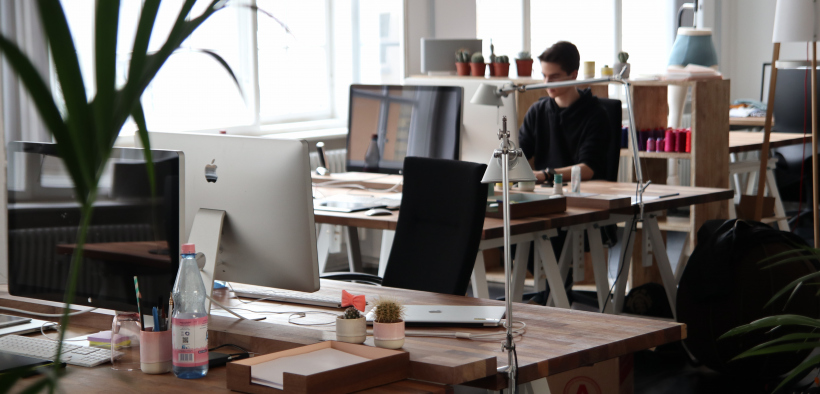How Businesses Can Keep Employees Safe While Transitioning Back to In-Office Work
Share

With the COVID-19 pandemic coming under control in many places around the world, employees are starting to get the call to head back to their place of work. Employers, likewise, are planning on how to make that transition happen when it is safe in their area. While there are still some worries about workplace safety, many employees are ready to get back to the normal office routine. Here are some helpful tips to ensure that your employees stay safe during the transition back to work.
Survey Your Staff
It’s always a good idea to try and understand how your employees are feeling. Ask if they want to return to the office, and how important returning to the office is to them. Follow up with questions about what safety precautions would make them feel better about returning. Inquire how they feel about masks, social distancing, temperature checks, and the use of comma areas like the break room.
Letting them know you are taking their feelings into account will make the transition smoother for the company. You might find out that many are eager to return while others are reluctant. If you can, make the move back to the office an optional one, or give them plenty of heads up to get used to the idea.
Reconfigure Spaces
The first safety fact that you need to consider is the six-foot rule. Think about how you can have employees practice social distancing upon returning. This may require you to reconfigure some of your spaces to allow for safer distancing. There are various apps online that you can utilize to get different seating scenarios. You’ll simply need to enter the existing layout of your building and let it generate the best reconfiguration scenarios for you.
Make Cleaning a Priority
When it comes to keeping your office a safe environment, cleaning is a necessity. There are tons of office cleaning services that you can hire to take care of your business. Be sure to check in with each to see what they’re doing to fight the spread of the coronavirus. While you may have had a cleaning service set up in the past, you may want to have them come in more often. This can help to sanitize surfaces to reduce the likelihood of your employees getting the virus.
Be sure to let your staff know what cleaning procedures are in place and what areas are regularly sanitized. If their desks aren’t on that list, they will know to clean up after themselves.
Sanitation Stations
In every workspace, you should consider including a sanitation station. A touchless hand sanitizer dispenser will help keep germs from spreading. Keep face masks on hand for employees to use in common areas. Encourage them to keep their work stations clean by providing disinfectant wipes. You might also include water bottles or individually wrapped snacks so you know your employees will visit the station regularly.
Making Changes to the Building
There are plenty of inexpensive upgrades you can make to help limit the spread of germs. Upgrading your air filtration systems is one you could do without disrupting the work day. Adding foot pulls to the base of your doorways limits contact between employees. Touchless water dispensers in place of the button-operated drinking fountains is another way that you can stop the spread of germs. Automatic soap dispensers in bathrooms and break rooms will encourage frequent hand washing, and they are more sanitary. Areas where people touch the same objects, such as magazines in the lobby or pens near sign-up sheets, should be addressed. Small changes will go a long way. Make sure you analyze what these risk are in your office building as many are so commonplace that they may slip your mind.
Implement Mandatory Screenings
One of the best ways to help combat the virus from being brought into the office is to implement mandatory employee screenings. This could be evaluating symptoms and taking temperatures. If any employees show signs of virus symptoms, they can be stopped before entering the common areas of your building. This will also help to keep employees who know they aren’t feeling right from coming to work.
Consider Phasing Employees Back
Instead of bringing all of your employees back at the same time, consider phasing. This can be done in a number of different ways. For example, you may bring back a select group of employees on Mondays and Wednesdays while others on Tuesdays and Thursdays. You may also want to consider that some employees would prefer to work remotely until they are comfortable with the state of the pandemic in your area. This can help to keep the number of people in your office to safe numbers each day during your operations.
Make Your Paid Leave Policies Clear
Employees may be hesitant to take time off if they are unsure how it will affect their standing with the company. Make sure they know what it required from them to take time off for COVID-19 related issues. This might include a positive test result from a doctor or proof of exposure through a sick family member. If your policies differ between unpaid time off and paid time off, let them know what their options are. They are more likely to take advantage and stay home if they know what the company policy is.
Be Flexible
You don’t want your company at the center of a local spike in new cases. If someone who has been working in the office tests positive, consider asking your staff to work from home for a few days while the building is sanitized. Many institutions have similar policies you could look into for a blueprint when creating your action plan. If you have high-risk employees, like those with diabetes or other co-morbidities, let them know they are free to work from home until they are comfortable returning.
Getting back to business may be something that you’ve been wanting to do for months. However, bringing back your employees comes along with a lot of risks. By implementing the safety tips above, you should be able to greatly reduce the risk of your employees contracting the virus at your office.

















